Daily Writing
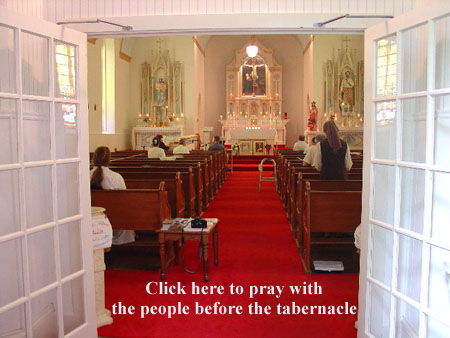
| Shepherds of Christ Daily Writing |
 |
March 15, 2009
|
March 16th Holy
Spirit Novena |
The Novena Rosary
Mysteries |
March 15, 2009
Blood and Water
poured forth from the
Heart of Christ
From Your pierced Heart
the Church was born
Blood and water flowed from the side
of Christ on the Cross
We receive the sharing in God's life
in baptism —
But Jesus is truly present
Body, Blood, Soul and Divinity in
the Eucharist
Jesus gives Himself to us in
an act of perfect love in
the Eucharist
John 6: 51
I am the living bread
which has come down from heaven.
Anyone who eats this bread
will live for ever;
and the bread that I shall give
is my flesh, for the life of the world.’
1 Corinthian 10: 3, 6
all ate the same spiritual food
these happenings were examples, for our benefit, so that we should never set our hearts, as they did, on evil things;
In the Mass — we know as the
spouse of the Lamb
A Prayer for Intimacy with the Lamb, the Bridegroom of the Soul
Oh Lamb of God, Who take away the sins of the world, come and act on my soul most intimately. I surrender myself, as I ask for the grace to let go, to just be as I exist in You and You act most intimately on my soul. You are the Initiator. I am the soul waiting Your favors as You act in me. I love You. I adore You. I worship You. Come and possess my soul with Your Divine Grace, as I experience You most intimately.
Song: His Presence Pervades My Soul
Song: I Love You Jesus
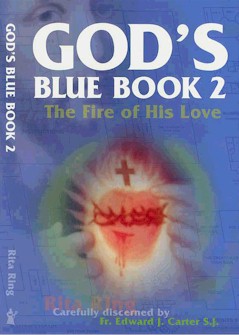
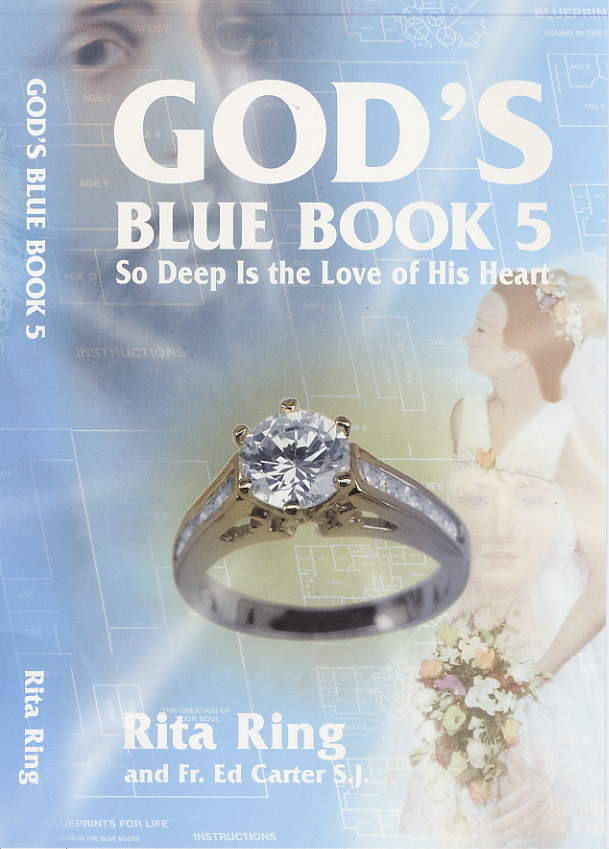
I eat His Body
I drink His Blood
7 Years Ago
From Mass Book II
March 15, 2002 After Mass
I just wanted to be alone with Him after communion. I wanted
intimacy with Him. I can go so deeply in an ecstatic experience
with Him. I want to be in such deep union with Him in my heart. When
I am one with Him I feel so one with the souls of the earth.
I feel one with those in the Church. I feel one with His chosen priests.
I long for the deep oneness amongst the people of the earth, as
He desires. My oneness with Him is always in that deep connection
with the Universal Church. My oneness reaches such heights in these
ecstatic experiences where I am so one with the Father, knowing
Him so intimately as His little child and loving so deeply all souls,
wanting so deeply in my soul the Father's will for all souls of
the earth.
My very deep connection is in such oneness with God, Father,
Son and Holy Spirit, I exist so deeply in God in the Mass, I want
what He wants, my prayer so deep within me is for the will
of God on this earth.
And I cannot help but constantly, incessantly tell God of my
deep, deep, burning love for Him at Mass. I am so united to God, I
know each Person so deeply and so intimately, the depth of this
union so far beyond this pen and paper. It is in knowing each
Person so intimately, in loving God more deeply every moment
of my existence here on earth that I relate so deeply with Him in
this Most Holy Sacrifice of the Mass.
My depth of union and my knowledge of the Father ever deepens
my desire for completeness with my God is the thirsting
within my soul.
My relationship with Jesus, my beloved Spouse, my Divine Bridegroom
takes on a deeper meaning every moment of my existence. My journey
into the spiritual life ever deepens. The flooding love within my
soul for God in the Mass I cannot ever explain. The Holy Spirit
fills my soul with the deepened presence of God's love.
March 15, 2002 continues
I am one in God. I want a deeper fullness in His divine Life.
I want completeness in Him. My heart longs for the beatific vision.
My God! I love Him so much. My deep love I cannot express.
I am taken into ecstasy in Him. My burning desire
for God in the Eucharist is so strong, I want Him, I
love Him, I want His Body and His Blood. I want this
intimacy with my God.
My soul cries for mercy for all the souls of the earth -
"Lamb of God who takes away the sins of the world
have mercy on us."
"Lamb of God who takes away the sins of the world
have mercy on us."
"Lamb of God who takes away the sins of the world
grant us peace."At the beginning of Mass, we beg for grace to be released,
with all my heart I cry to our God.
Oh my tongue is parched and my soul longing for God.
I cry the day long for grace to be outpoured on the hungry
souls.
I feel so much depth in my heart when I communicate with Him.
I pray for the souls of the earth and our priests and our
Church and I know He hears me.
This is the promise God gave to Fr. Carter for those who pray
the Shepherds of Christ prayers.
13th Promise
Jesus speaks: "...I am calling many to become members of Shepherds of Christ Associates. To all of them I will give great blessings. I will use them as instruments to help bring about the triumph of the Immaculate Heart and the reign of My Sacred Heart. I will give great graces to the members of Shepherds of Christ Associates. I will call them to be deeply united to My Heart and to Mary's Heart as I lead them ever closer to My Father in the Holy Spirit."
— July 31, 1994
March 15, 2002 continues
To those Churches who pray these prayers Jesus has given
so many promises.Look at this my faithful ones.
Do you think God would give such a sign for no reason.
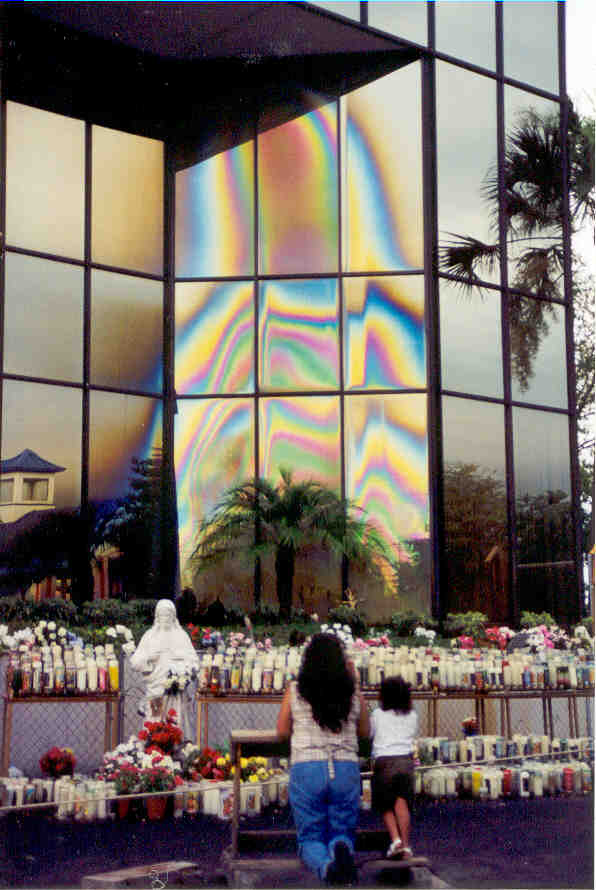
July 5, 2000
March 15, 2002 continues
And He picked a priest in good standing, author of all
these books on the spiritual life to carry the
message.
It is intimacy we all crave and
God wants this intimacy with men.
This is the message.
The sickness is this: many seek intimacy, they
crave this, but they look in the wrong places.
Jesus promised Fr. Carter greater intimacy to those
who pray the prayers.
This is about this ever deeper union with the Father, Son
and Holy Spirit our souls crave.
The following writing was written by Fr. Carter in 1967-
33 years before the end of the second millennium.
This has been translated in 3 other languages early in
the seventies.end of excerpt from March 15, 2002
Excerpt from Response in Christ (by Fr. Edward J. Carter, S.J.):
FOUR The
Sacraments
and the Mass
Within this consideration of immolation it will be profitable for us to refer to three basic types of sacrifice common to the Jews of the Old Law. Such a consideration will have its special significance in our treatment of Christ's sacrifice. The three sacrifices in question are those of the paschal lamb, of the covenant, and of expiation or atonement. In our initial chapter we discussed the first two types. It is sufficient to recall here that each of these, through sacrificial blood, was instrumental in uniting the Jews with Yahweh as His people. The blood of the paschal lamb contributed to the Jewish exodus from Egypt, an exodus which attained upon Mount Sinai a central point of its progress toward the promised land. Here upon Mount Sinai the sacrifice of the covenant took place as the blood sealed the new life relationship between Yahweh and the Jews.
In the sacrifice of expiation or atonement we again see the key role of sacrificial blood. In this sacrifice the blood was sprinkled seven times over the propitiatory. The purpose of this was to purify the sanctuary from all the sins of Israel. In turn the altar was sprinkled seven times with blood in order to achieve its purification and sanctification.
The purpose of the sacrifice of expiation or atonement, then, was purification and divine reunion. The land of Israel together with the tabernacle, the altar, the sanctuary and the throne of Israel, had been stained by the sins of the Chosen People. Through these sins God had been driven from their midst. In the sacrifice of expiation God returns to Israel through the purification of the tabernacle. The tabernacle symbolized the souls of the Jews, so we note that God returns to a purified people. Here we see a simultaneity of purification and reunion.10
Taking together these three main sacrifices of the pasch, covenant, and expiation, we see the role of the shedding of blood in the history of the Israelites. The shedding of blood purified and united to God, and indeed played a most positive role.
4) Acceptance of the Sacrifice by GodIn order that the sacrifice might reach its extrinsic consummation God on His part must accept it. God's acceptance of sacrifice has been shown in various ways. Among the Hebrews assurance of the divine acceptance was seen in the phenomenon of fire falling from heaven and consuming the victim of sacrifice. In the absence of such a heavenly token, there was at least some assurance that God accepted the sacrifice because of the duly consecrated altar itself. The altar received the gifts of sacrifice, and in doing so symbolized God's acceptance of the same.
5) Partaking of the Sacrificial VictimIn the history of sacrifice men have habitually shown a desire to accept God's invitation to partake of the offered victim. God must invite men to participation in the sacrificial meal, for the victim of sacrifice becomes divine property, and the use of it contrary to the divine will is sacrilegious. If God is pleased to admit His friends to the divine banquet, this is a manifestation of the divine goodness.
Since the victim has in a certain way become divine through its being offered to God, the partaking of this victim has a deep significance. Through such a participation in the divine banquet one shares in the sanctity of the victim.11 This sharing in the holiness of the victim is actually a participation in God's sanctity, since the victim is holy with the holiness of God to whom it has been offered.
Thus the cycle of sacrifice has been completed. The interior giving on the part of those offering the sacrifice, exteriorized and symbolized by the ritual offering of an immolated victim, has brought down from on high a divine communication.
We have briefly seen the general economy of sacrifice, the authenticity of which has been borne out by history. This structure of sacrifice is authentic because it is partly rooted in the very nature of man. At the same time, this structure has been modified by the demands of positive law. With this general structure of sacrifice serving as a background, we are now in a position to consider the sacrifice of Our Lord Jesus Christ, and finally, that of the Mass.
b) Christ's Sacrifice
We will consider Christ's sacrifice according to the same constituent elements of sacrifice already discussed. In this treatment we will follow the theory of the unicists, who hold that Our Lord offered only one complete sacrifice as opposed to the dualist theory which says Christ offered two complete sacrifices, one at the Last Supper, and one on Calvary. The Church allows either position. We prefer to follow the position of the unicists, since this seems to give a greater unity to Christ's sacrifice, and indeed to the total mystery of Christ. This profound unity of Christ's mystery has become more and more apparent with the scriptural, liturgical and theological renewals.12
1) The Interior offering of Our Lord
The sacrifice which Christ offered for the redemption of the world was first and foremost an interior moral act. Christ's life possessed its great value because of His interior dispositions. His entire life was a constant gift of Himself in love to the Father and to mankind, and Calvary was the supreme expression of this gift. This gift of self was regulated by a perfect conformity to His Father's will.
Christ not only was constantly living out this interior disposition of sacrifice, but He strove to inculcate the necessity of it in the Jews of His time. He constantly opposed a false and legalistic concentration on the mere externals of Jewish purifications, for such an attitude tended to diminish the necessary internal dispositions. The synoptic theology of sacrifice stresses this attitude of Christ. Bernard Cooke states: "This insistence of Jesus on internal dispositions characterizes the Synoptic theology of sacrifice, which continues and completes the prophetic emphasis on the moral and individual aspect of sacrifice. . . . One must be careful, however, not to exaggerate the opposition (either in the prophets or in the Synoptic Gospels) between cult and internal dispositions of soul."13
2) Ritual Oblation
As we have said, man, because of his corporeal and social nature, has always desired to express the interior oblation of sacrifice in an external, ritual oblation. So it was with Christ. Unlike the dualists, who maintain that Christ's interior offering was sufficiently exteriorized during the passion itself, the unicists maintain that the only place where we can locate a ritual oblation is at the Last Supper. This ritual oblation cannot be found in any other phase of Christ's sacrifice – from the Garden to the Cross – despite the efforts of some to do so. Notice, too, that in the case of Christ's sacrifice, the ritual oblation of the Last Supper is of a victim-to-be-immolated rather than of a victim already immolated.
Christ's ritual oblation at the Last Supper possessed a many-faceted signification. We will comment on several aspects. We begin by recalling the social implications of the ritual oblation. This social element is present in Christ's actions at the Supper. He told the Apostles to do what He was doing in commemoration of Him. This would assure that in the future the head and members of the Church would sacramentally renew Christ's redemptive, sacrificial act. In this manner the members of Christ's Body would not passively receive the graces of Christ's sacrifice, but rather would assimilate these graces by actively entering into Christ's act of atonement. Consequently, Christ's sacrifice, in its perennial, sacramental renewal down through the ages, was to be of a social, corporate nature.
Closely related to this social aspect of Christ's actions were the covenant significations of the Last Supper ritual. This is brought out by observing the connection of Christ's actions with two of the chief types of Jewish sacrifices we have previously mentioned, the sacrifice of the pasch and that of covenant. In both of these the concept of sacrificial blood enters in.
The Last Supper was a paschal meal, or at least had a paschal significance. The Jewish paschal meal commemorated the Jewish people's delivery from Egyptian slavery, which, in turn, symbolized their deliverance from sin. The enslaved Jews had been freed from Egyptian tyranny with the aid of the blood of the paschal lamb. For this blood, we recall, had exempted Jewish homes from the visit of the exterminating angel. How fitting, then, that at the paschal supper Christ instituted the eucharist in which His blood is sacramentally shed. He is the new paschal lamb whose blood frees us not from Egyptian slavery but from slavery to sin. The old pasch, a covenant communion between Yahweh and His chosen people whom He delivered from Egypt, gives way to the new pasch, the new covenant communion between God and His people.
These ideas concerning covenant lead us to a consideration of the second type of Jewish sacrifice linked with Christ's actions at the Last Supper. We recall that in the sacrifice of the covenant Moses sprinkled sacrificial blood on both the altar representing Yahweh and the people. This blood, considered to be source of life, united Yahweh and His people in a union, a common life, or, in other words, a covenant. We understand, consequently, the deep significance of Christ's words at the Last Supper when He referred to His blood as being that of the new covenant. This is the blood which establishes between God and men a new union, a new covenant.
3) Immolation of the Victim
The central importance of Christ's sacrificial blood is evident. It is the blood of the new paschal lamb. It is the blood of the new covenant, the blood which redeems man. The shedding of this blood occurred during the immolation of Christ's passion-death. Schillebeeckx points out the significance of this immolation in blood: "The Blood of Christ is a theme that is truly central in the primitive Church, as Scripture shows it to us. This death sanctifies mankind, reconciles, establishes peace, redeems, constitutes the Church, and therefore unites man in communion with God and his fellow men. We are redeemed in sanguine, through the blood of Christ – this we find on almost every page of Scripture. It is impossible therefore to spiritualize Christ's sacrifice, to make it merely an internal act of love. There was indeed the act of love, but it was embodied in the sacrifice of blood."14
At this point we also note the profound unity of Christ's sacrifice. We observe that priest and victim are one and the same. At the Last Supper, Christ is chiefly priest; on Calvary, He is chiefly victim. Yet He is always priest and victim. Christ does not perform the immolation. He rather endures it. However, this is sufficient since it is not necessary for the priest of the sacrifice to achieve the immolation himself.
4) The Father's Acceptance of Christ's Sacrifice
We have demonstrated that one of the constituent elements of sacrifice is its acceptance by God. In the case of Christ's sacrifice, this acceptance by the Father was accomplished in a most glorious fashion – through Christ's Resurrection and Ascension. The Father glorified His Son for the perfect, whole-hearted sacrifice of Calvary. This glorification shall endure for all eternity, since Christ reigns at the right hand of the Father as eternal victim, as eternal, glorified victim. Through this glorified Christ the treasures of His sacrifice are distributed to all men: "Christ's glorification is the mystery whereby the treasures of his divinity flow to us, through the opening of his mortal life."15
In the union of these last two elements of Christ's sacrifice, His immolation in death and the acceptance of His sacrifice through the Resurrection and Ascension, lies the essence of Christ's redemptive act – of course, in saying this we presuppose the first element of Christ's sacrifice, His interior disposition or oblation; this is the essential element. This union of Christ's death and Resurrection is called His paschal mystery, His passover. In what did this passover or transition consist? In our initial chapter we briefly described this passover of Christ. We will now expand to some extent upon this basic reality of Christ's life.
The divine love, or agape, descended into this world for the salvation of men. This saving force manifested itself to men through the redemptive activity of the Word made flesh. By becoming man, Christ, although free from sin, submitted Himself to the conditions and circumstances of a sinful world. His redemptive activity consisted in a struggle with the forces of evil. As this struggle developed, Christ at the same time was returning to the glory of His Father. He finally conquered completely through His paschal mystery. Through His death He liberated Himself completely from a world impregnated with sin and passed over into the new order of the Resurrection. Moreover, Christ experienced this transition process not just for Himself. By His own passover Christ achieved for all men the opportunity to pass from death to life, from a life of sin to a new life as sons of God. In the words of Lyonnet, "The redemption is essentially the return of humanity to God. The return is accomplished first of all in Christ who died and rose again as the first fruits of this humanity (objective redemption), and then in each Christian who dies and rises again with Christ in baptism (subjective redemption)."16
Consequently, we have observed, in terms of sacrificial elements, the most intimate union which exists between Christ's death and Resurrection. They are inseparable, and lie at the heart of the total mystery of Christ. This paschal mystery is central, therefore, to the liturgy and to the whole Christian life.
5) The Banquet in Christ's Sacrifice
The cycle of sacrifice is strikingly completed by God graciously extending an invitation to partake of the offered victim. This element of sacrifice is miraculously fulfilled in Christ's oblation. By the words of consecration the bread and wine become Christ. In this manner Christ gives Himself to His disciples at the Last Supper. We will further develop these ideas of eucharistic communion in our consideration of the Mass.
We hereby complete the consideration of the elements of Christ's sacrifice. According to the unicists there was but one sacrifice of Christ. The Last Supper, death and Resurrection each contributed essential elements. This one sacrifice of Christ endures in its efficacy for all time. In itself it is not to be repeated. Its sacramental renewal, however, is repeated daily on our altars in the Mass.c) The Sacrifice of the Mass
Some contemporary authors, while not necessarily de-emphasizing the sacrificial nature of the Mass, are giving a renewed emphasis to the concept of the Mass as banquet or meal. This is all to the good, as long as the sacrificial structure is not allowed to recede to the background. In this regard it is well for us to recall the mind of the early Church. Jungmann says: "The first centuries of Christianity, which had built the framework for the celebration of the Eucharist which is still followed today, had laid down two basic thoughts: The Mass is the memorial of the Lord, and it is the sacrifice of the Church. These two thoughts are expressed just as clearly and simply today: '. . . calling to mind the blessed passion – we offer to your sovereign majesty – this pure sacrifice.' "17
We should always unite the concepts of the Mass as sacrifice and the Mass as meal by realizing that the eucharistic meal is an integral part of the sacrifice. It is its conclusion.
We should also be aware that the Mass is a covenant sacrifice. It is the sacramental renewal of Christ's covenant sacrifice. The Mass is the central act of our covenant life in Christ, and therefore it embraces the four great dimensions of covenant love. In Christ, by the action of the Holy Spirit, we open ourselves in a special manner during the eucharistic liturgy to the Father's love and we respond to that love. In Christ and His Spirit we also pledge ourselves at Mass to go out in a deeper love to the members of the People of God and to all men. We also commit ourselves anew to be open in receiving the love of others. According to these various perspectives, the Mass above all is an action of love.
1) Interior Oblation of the MassThe chief priest and victim of the Mass is the same as the priest and victim of the Last Supper and Calvary, Christ Himself. Christ makes this interior offering of Himself in the Mass for the same ends as were present in His own unique sacrifice – adoration, thanksgiving, petition and satisfaction.
However, Christ is not the only priest at the Mass as He was at the Last Supper and upon Calvary. All the members of the Mystical Body are priests along with Christ. To be sure, there is a difference between the hierarchical priesthood of bishops and priests and the universal priesthood of the faithful. This difference is one of essence and not merely degree. The point we wish to stress, however, is that the universal priesthood is a real participation in Christ's priesthood given through the sacraments of baptism and confirmation.
This concept of the priesthood of all the Church's members is being stressed today in a special manner.18 Jungmann, the outstanding liturgical theologian, gives us reasons why this concept of universal priesthood became relatively obscure for so many years. He states that the concept of the Mass as the Church's sacrifice faded into the background as a result of the Reformation. The Reformers maintained that there was only one sacrifice, the one which Christ offered upon Calvary. To counteract this heresy the Council of Trent and the theology consequent to it had to clarify that the Mass is a true sacrifice, but not an absolutely independent one. It is a sacrifice relative to the absolute one of Calvary and a representation of it. It was emphasized that the priest of Calvary is also the chief priest of the Mass. Because of such doctrinal controversies, the concept that Christ offers the Mass was alone considered important. The concept that the Mass is also the sacrifice of the Church practically disappeared. Finally, Jungmann notes that today we are returning to the balanced view which meaningfully recognizes that the Mass is not only the sacrifice of Christ, but also that of the Church.19 This stress on the Church's part in the Mass is logically connected with the contemporary emphasis on the priesthood of all the members of the People of God.
As Christ is not the only priest of the Mass, neither is He the only victim. Again, all the members of the Church are victims along with Christ. Various Church documents attest to this. For instance, Pope Paul VI officially calls attention to this: "It is a pleasure to add another point particularly conducive to shed light on the mystery of the Church, that it is the whole Church which, in union with Christ functioning as Priest and Victim, offers the Sacrifice of the Mass and is offered in it."20 Therefore, the members of the People of God, united as priests to Christ the high priest, offer a combined victim to the Father: Christ and themselves. Such then in all its deep meaning and beauty is the first sacrificial element of the Mass.
2) Ritual Oblation of the MassJust as Christ's interior offering of Himself was externalized in a ritual oblation at the Last Supper, so is there an external, liturgical rite of the Mass. The importance of this many-faceted exteriorization is brought out by Vatican II's Constitution on the Liturgy.
As mentioned before, this exteriorization of the internal oblation is according to man's social and corporeal nature. That it is in harmony with the social part of man is evident from the fact that the external rite assembles the People of God to worship together as a community. The individual members are consequently enabled to help one another to achieve the proper worship of God. The Constitution gives stress to this social aspect of the liturgy. It states that the very nature of the liturgy demands that all the faithful be led to a full and active liturgical participation. Such is in keeping with their vocation as "a chosen race, a royal priesthood, a consecrated nation" (1 P 2:9). The Constitution emphatically states that such full and active participation on the part of all the people is the chief aim of the liturgical renewal.21
As also previously observed, the external rite is likewise according to man's bodily nature. In the case of the Mass (and the sacraments also) we observe that the very validity of the sacrifice depends on having the proper materials for the offering – bread and wine – and on the use of the proper form of consecration. The external, the ritual, the sensible, are indeed indispensable.
In all this we note the great law of incarnation. The Incarnation established a set pattern for the redemption of the world, redemption taken both objectively and subjectively. Christ redeemed the world through His sacred humanity. This humanity is, then, the gateway to the divinity, to eternal life.
As Christ's created humanity was indispensable for accomplishing the sacrifice of the objective redemption, so are created things necessary for the eucharistic sacrifice of the subjective redemption. This fact calls to mind the thought of Teilhard de Chardin. Teilhard holds a world concept in which all things, natural and supernatural, spiritual and material, are united in a single and organic unity. The pole of this unity is the person of the Incarnate Word, towards whom the whole of creation converges.22 In such a concept the law of incarnation is developed to the utmost, a fact brought out by the following words of Teilhard: "Let us remember that the supernatural nourishes itself on everything."23
At various times in the history of Christian spirituality, the Church has been plagued with an exaggerated spiritualism rising out of various sources. Such a spiritualism, looking upon material things as more of a hindrance than a help, is foreign to the true Christian spirit. A true theology of the Incarnation, a theology which the Church so well concretizes in her liturgy, can lead to no other conclusion.
It is no accident that a meaningful incarnation spirituality is developing concomitant with the liturgical renewal. Although we would not want to say that the incarnational element outweighs the transcendent element in the Church's portrayal of the Christian life, yet she is leading the faithful of all vocations to a deeper incarnationalism. The Church is accomplishing this through a variety of ways. She is achieving this incarnationalism, for instance, through the great social encyclicals, through the documents of Vatican II, and, in reference to our present topic, through a revived liturgy.
There is a deep significance, and a rich world of thought connected with the second sacrificial element of the Mass: the ritual oblation which incarnates the interior oblation.
3) Immolation of the VictimChrist, the chief victim of the Mass, has been immolated once and for all in the offering of His own unique sacrifice. And yet, since the Mass is a true sacrifice in its own right, we logically look for an unbloody immolation of Christ the victim. Where do we find this immolation? Traditionally it has been seen to be present in the double consecration of bread and wine. This double consecration symbolizes the separation of Christ's blood from His body, and, consequently, symbolizes His death. Pius XII's encyclical, Mediator Dei, states: "Thus the commemorative representation of His death, which actually took place on Calvary, is repeated in every Sacrifice of the altar, seeing that Jesus Christ is symbolically shown by separate symbols to be in a state of victimhood."24 Jungmann reminds us of the importance of this sacramental immolation of Christ. While admitting and even stressing the importance of giving the "meal symbolism" its proper place in the Mass, Jungmann calls for a priority of sacrificial symbolism: "It is quite another question whether or not it is necessary or even correct to regard the meal symbolism as the decisive and fundamental thing in the outward transaction of the Mass. If the Mass is a sacrifice then this must find appropriate expression in the outward picture too; for sacrifice is essentially a demonstrative action, the symbolic representation of inward readiness to give oneself."25
Durrwell, a biblical theologian, also highlights the importance of the Mass's immolation. He seems to say that Christ's immolation is symbolized by the very words of consecration. He says that the Last Supper and its commemoration, the Mass, are sacrificial meals. Consequently, ". . . Christ appears in the victim state. He gives them to drink "the blood of the new covenant, shed for many' (Matt, Mark), blood of sacrifice as the establishment of the old covenant required (Exod xxiv, 8) shed at the moment of drinking."26
However, as we have said, Christ is not the only victim of the eucharistic sacrifice. The members of His Body, the Church, are also victims along with Christ. Those members must also be in a state of victimhood. As with Christ, they cannot undergo a bloody immolation. Their immolation must also be a mystical one. How is this accomplished? We can look to two passages of the encyclical Mediator Dei for thoughts on such a mystical immolation. In one passage we read that pride, anger, impurity and all evil desires are to be mystically slain. As the Christian stands before the altar, he should bring with him a transformed heart, purified as much as possible from all trace of sin.27 Positively considered, such a transformation means that the Christian is striving to grow in the supernatural life by all possible means, so as to present himself always as an acceptable victim to the heavenly Father.
In another passage of the same encyclical this mystical immolation of Christ's members is further developed. To be a victim with Christ means that the Christian must follow the gospel teaching concerning self-denial, that he detest his sins and make satisfaction for them. In brief, the Christian's victimhood means that he experiences a mystical crucifixion so as to make applicable to his own life the words of St. Paul, "I have been crucified with Christ. . ." (Ga 2:19).28
Jungmann has a beautiful passage concerning the Christian's eucharistic immolation. He states: "Every sacrament serves to develop in us the image of Christ according to a specified pattern which the sacramental sign indicates. Here the pattern is plainly shown in the double formation of the Eucharist; we are to take part in His dying, and through His dying are to merit a share in His life. What we here find anchored fast in the deepest center of the Mass-sacrifice is nothing else than the ideal of moral conduct to which the teaching of Christ in the Gospel soars; the challenge to an imitation of Him that does not shrink at sight of the Cross; a following after Him that is ready to lose its life in order to win it; the challenge to follow Him even, if need be, in His agony of suffering and His path of death, which are here in this mystery so manifestly set before us."29
Summarily, then, we become victims with Christ by lovingly conforming our wills to the Father's will in all things. Such conformity was the essence of Christ's sacrifice, of His victimhood, and of His immolation. A similar conformity must be in the victimhood and the immolation of Christ's members. This mystical immolation is a lifelong process. The ideal is that each Mass participated in by the Christian should mark a growth in his victimhood. The true Christian desires to die more and more to all which is not according to God's will so that he may become an ever more perfect victim with Christ.
4) The Father's Acceptance of the Eucharistic SacrificeIt has been observed that if sacrifice is to have its desired effect, it must be accepted by God. That the Father always accepts the eucharistic sacrifice is certain. For the principal priest and victim is Christ Himself, always supremely acceptable to the Father. As for the subordinate priests and victims, they are, taken together, the People of God, the Church herself.
There is always an acceptance on the Father's part even as regards this subordinate priesthood and victimhood of the Mass. For even though the Mass may be offered through the sacrilegious hands of an unworthy priest, there is always a basic holiness in the Church pleasing to God. Because of such holiness the Father always accepts the Church's sacrificial offering, for the Mass is the sacrifice of the whole Church, and cannot be fundamentally vitiated by the unworthiness of any particular member or members, even if that member be the officiating priest.
What do we say concerning the Father's acceptance of the sacrificial offering of the individual Christian? Such an offering will be acceptable in proportion to the Christian's loving conformity of will to the Father's will. Speaking of the Christian's participation in the Mass, Jungmann says: "It follows that an interior immolation is required of the participants, at least to the extent of readiness to obey the law of God in its seriously obligatory commandments, unless this participation is to be nothing more than an outward appearance."30
Having considered in successive sections the immolation and acceptance elements of the Mass, we should consider the vital link between these two. For just as the two are inseparably connected in Christ's sacrifice, so are they also united in the Church's sacrifice of the Mass.
In Christ we equated the immolation of His sacrifice with His passion-death, and the acceptance element with His Resurrection. Uniting these two mysteries of death-resurrection, we spoke of Christ's paschal mystery. We have seen that this mystery had been prefigured by the Jewish pasch and exodus, component parts of the Jewish people's transition to a new and more perfect life. In the case of Christ, we considered His pasch – His passover – to be a transition from the limitations of His mortal life to the state of resurrected glory. We speak of Christ's mortal humanity as having exercised limitations upon Him in this sense, that, although He Himself was completely free from sin, He had exposed Himself to the conditions of a sin-laden world through His human nature. In His death-resurrection He changed all this as He conquered sin, as He redeemed us, as He passed to the state of glory with His Father.
What happened in Christ also occurs in His Mystical Body, the Church. The Church and Her members experience their own transition from death to resurrection. The entire Church and the individual Christian express, through the Mass, a willingness to grow in the participation in Christ's death. The Father accepts this willingness and gives an increase in the grace-life, a greater share in Christ's Resurrection. This process happened within a short span of time in Christ's life. In the life of the Church it continually takes place until Christ's second coming. The Church, with her grace-life of holiness, has already partially achieved her resurrection, but not completely, even though she continues to grow in grace. St. Paul bears witness to this: ". . . but all of us who possess the first-fruits of the Spirit, we too groan inwardly as we wait for our bodies to be set free." (Rm 8:23).
Vatican II's Constitution on the Church beautifully portrays this fused state of death-resurrection which the Church in her members experiences here below as she awaits the fullness of the resurrection in the world to come: "For this reason we, who have been made to conform with him, who have died with him and risen with him, are taken up into the mysteries of his life, until we will reign together with him. . . While still pilgrims on earth, tracing in trial and in oppression the paths he trod, we are anointed with his sufferings as the body is with the head, suffering with him, that with him we may be glorified. . ."31
5) Partaking of the Eucharistic MealThe cycle of the eucharistic sacrifice is completed as the priest and faithful partake of Christ the paschal lamb. The People of God have given Christ to the Father. Now the Father gives Christ to the Church's members in the eucharistic meal. Although the priest alone must communicate to assure the integrity of the sacrifice, it is highly desirable, of course, that all present partake of the eucharist.
In the sacrifices of old, the victim of the sacrificial banquet was considered in some sense divine by the fact that it had been offered to the divinity. In the sacrifice of the new covenant we receive divinity itself through the sacred humanity. With such a marvelous conclusion to the eucharistic sacrifice, the fruits of Christ's sacrifice of Calvary are continually experienced.
There are other truths to be considered under the paschal meal aspect of the Mass. One of these is the concept of the eucharist as sign and cause of unity. Von Hildebrand comments on this: "All receive the one body of the Lord, all are assimilated into the one Lord. Even if we leave aside the supreme ontological supernatural unity which is realized here, the very act of undergoing this experience represents an incomparable communion-forming power."32
Through the sharing of the one paschal lamb, the Christian assembly has thus been vividly reminded of their oneness in Christ. Yet this is a oneness in plurality. For each Christian is a member of the one Body of Christ in his own unique way. He has been called upon to assimilate Christ according to his own personality, vocation and graces. Consequently, just as the members of the People of God are reminded of their unity at Mass, so are they made aware of their own uniqueness as they depart from the eucharistic assembly, each carrying Christ to his own particular environment according to his own individual personality.
We have considered the Church's eucharistic sharing in the mystery of Christ according to a sacrificial structure. With the general structure of the Mass established, we will now enlarge upon the concept of the participation of the individual.
d) The Christian's Participation in the Mass
God has created man a social being. This fact has relevance as regards man's salvation and perfection. Man does not go to God alone, but rather is saved and perfected with and through others. This is evident in the study of salvation history as one observes God communicating Himself to man in the framework of community. As we have seen, this social dimension is also readily evident in the liturgy.
As we now discuss the individual's participation in the liturgy, we in no way intend to underestimate the communal aspect of the eucharistic sacrifice. We constantly presuppose it and its importance. Liturgy as communal is the indispensable framework and background for any discussion of the individual's liturgical participation.
Granted all this, it is still useful and necessary to speak of the individual's participation in the Mass.33 Ultimately it is the individual as individual who accepts or rejects God's offer of salvation and sanctification. Therefore, to speak of the individual's response to God in the liturgy is highly significant. Despite all the communal helps the individual receives in the liturgy, despite the fact that the individual must always be deeply aware that he is a member of the community, the People of God, it is still true to say that it is within the depths of his own mysterious, individual personality that the Christian either becomes a mature Christian through the liturgy or fails to do so. With such preliminary ideas established, let us now consider the Christian and his role in the Mass.
1) The Baptized Christian and the MassOnce again the reader is reminded that through baptism the Christian becomes incorporated into Christ and His Church. Confirmation perfects this incorporation. Although baptism incorporates us primarily into Christ's death and Resurrection, we again stress that it also unites us with Christ in all His mysteries. This is so because all Christ's mysteries are essentially one mystery, for none of them stands separately by itself. Consequently, one cannot be initiated into Christ's paschal mystery without simultaneously being incorporated into all of His mysteries.
The fact that all of Christ's various mysteries are contained in the total mystery of Christ enables the Christian to encounter the entire Christ in the liturgy. Mention of this fact brings us to our next point.
In baptism the Christian first encounters and relives the mystery of Christ. He thereby receives a new life. But this life must be nourished. The Christian must constantly re-encounter the mystery of Christ, and this he does chiefly through the eucharistic liturgy. Here the Christian is daily privileged to encounter Christ in the most intimate fashion. Here above all he exercises his priesthood and consequently grows in supernatural vitality. We use the word exercise purposely, since the liturgy is primarily an action, an exercise of the priestly office of Christ.
Since the baptized Christian is sacramentally participating in the mystery of Christ at the Mass, his priestly act must be modeled after that of Christ's. This is true because the life of grace flowing out of the seals of baptism and confirmation is structured according to certain modalities or characteristics based on the life of Christ. This truth was developed at some length in the previous chapter. There we stated that Christ, the head of the Mystical Body, has determined, through His own life of sanctifying grace, the general lines of development according to which His members' lives of grace grow and mature.
Therefore it is evident that the whole of the Christian's life must be orientated to the Mass and be centered about it; for in Christ we see His entire life centered around His priestly act of Calvary. This is true because His interior sacrificial disposition, the essence of His priestly act, permeated everything in His life.
The baptized Christian should also bring his daily life, his whole life, to the eucharistic sacrifice. The Church which assembles about the altar is not a nebulous, ethereal entity, but the Church of this earth. It is the Church of men and women who are immersed in the work of this world. As they gather for the eucharistic sacrifice, they are therefore not removed from the world of their ordinary daily lives to an unreal world of ritual which has no connection with their temporal cares and activities. Rather it is the reality of this ordinary daily life which they bring to offer as priests and victims in union with Christ, priest and victim. In such a manner, then, the eucharistic sacrifice looks to the past life of the Christian.34
Yet the Mass also looks to the future of the Christian. By his participation in the Mass he receives grace to assimilate in a more perfect manner the mystery of Christ. Ideally, each Mass participated in by the Christian should mean that he leaves the eucharistic assembly with a greater Christ-likeness. Thus he takes up his daily life as a more fervent Christ-bearer.
The Mass as it looks to both the past and future embraces the Christian's entire life. It is meant to be lived each minute of the Christian's life. Durrwell says: "The Mass is said in order that the whole Church and the whole of our life may become a Mass, may become Christ's sacrifice always present on earth. St. Francis of Sales resolved that he would spend the whole day preparing to say Mass, so that whenever anyone asked what he was doing, he might always answer, 'I am preparing for Mass'. We also could resolve to make our whole lives a participation in the divine mystery of the Redemption, so that when anyone puts the question to us, we can always answer, 'I am saying Mass'."35
2) The Mass lived outAs the Christian lives out the Mass, he is consequently daily laboring with Christ in furthering the work of the subjective redemption. This is so because Christ's sacrifice was a redemptive act, and the Church's reliving of this act in the Mass is also redemptive. In this regard we must remember that the entire universe – not merely man – has been redeemed. The nonrational and rational world alike await the furthering of the redemption. St. Paul tells us: "From the beginning till now the entire creation, as we know, has been groaning in one great act of giving birth; and not only creation, but all of us who possess the first-fruits of the Spirit, we too groan inwardly as we wait for our bodies to be set free." (Rm 8:22-23).
How does the Christian help Christ redeem the world? (Henceforth the term "world" is to be understood as including both rational and nonrational creation.) As previously stated, the Christian helps Christ redeem the world by reliving Christ's mysteries. The same "events" or mysteries which accomplished the objective redemption further the subjective redemption also. Since at the heart of Christ's mysteries are His death and Resurrection, it is especially these that the Christian must relive. As the Christian dies mystically with Christ through loving conformity with the Father's will, he rises with Christ to an ever greater share in the Resurrection, in the newness of life, in the life of grace. As the Christian in this manner relives the paschal mystery of Christ, he is accomplishing not only his own redemption, but he is also, in a mysterious yet real manner, helping Christ redeem the world.
Although Christ's life was summed up in death-resurrection, it also included various other "events" or mysteries. Each of these in its own manner contributed to the redemption. So it is with the Christian's life. His participation in Christ's death-resurrection must be "broken down" into the other mysteries of Christ's life.
The Christian must always remember that he carries away from the Mass not only the Christ of the death and the Resurrection, but also, for example, the Christ of the hidden life and the Christ of the public life. As the Christian lives out his Mass in the exercise of his Christ-life, all these various mysteries should therefore be present.
Before we give examples of how the Christian can relive these saving events of Christ's life, it is well that we first distinguish the two different levels on which the Christian assimilates the mystery of Christ.
Christ, through His death and Resurrection, has transformed us. This transformation is a "new creation," a new life of grace. Through our baptism we are initiated into this life and consequently we exist as new creatures. As long as we possess the life of sanctifying grace, which is our share in the mystery of Christ, we are living according to this new existence whether or not this life here and now incarnates itself in a concrete, supernatural act. In this sense the life of grace, the "new creation," is fundamental, radical and transcendent, a share in the transcendent holiness or mystery of God Himself.
However, God expects that our life of transcendent holiness incarnate itself in concrete supernatural acts. It is in this respect that we speak of reliving the various mysteries of Christ through specific supernatural attitudes and acts. This may also be called imitation of Christ, but with a certain precaution, namely, that the imitation in question is to be considered primarily as interior rather than exterior. By this we mean that although the Christian can to a certain extent imitate Christ according to what was His external mode of conduct, it is primarily through adopting the mind of Christ – His interior dispositions – that the Christian puts on Christ. With this said we now offer suggestions as to how the Christian relives the mysteries of Christ whose presence and transforming influences have been encountered in the eucharistic liturgy.
For instance, each member of Christ, whether he be bishop, priest, religious or layman, can accomplish much of his redemptive work by an intense reliving of Christ's hidden life. Certainly our heavenly Father would have us learn a great lesson from this fact, namely, that His Christ lived out so many years of His earthly life in a hidden manner, doing the ordinary tasks of the ordinary man. In assimilating this particular mystery of Christ the Christian must say with Rahner: "Let us take a good look at Jesus Who had the courage to lead an apparently useless life for thirty years. We should ask Him for the grace to give us to understand what His hidden life means for our religious existence."36
Christ did not lead only a hidden life, but a public life also. All vocations within the Church are likewise called upon to reproduce this part of Christ's life in some manner. One aspect of Christ's public life that should be common to all Christian vocations is the selflessness, the constant concern and love for others which Christ constantly and vividly displayed. This concern for others cost Christ much in fatigue of body and mind. Nevertheless, He continuously gave Himself completely to others.
Another characteristic of the public life which all can imitate is that of Christ as witness. Here, then, we reemphasize within our present context that which was stated in an earlier chapter concerning the Church's continuation of Christ's prophetic role. Christ was a witness to the Father, a perfect manifestation of the Father's truth and love. He bore this witness not only through His formal teaching but also through His actions, His attitude, His gestures. All members of Christ are called to give witness also. The Christian's entire life should be a witness to the truth he holds. The world comes to know Christ through the Christian. Schillebeeckx comments on this aspect of being witness: "Our life must itself be the incarnation of what we believe, for only when dogmas are lived do they have any attractive power. Why in the main does Western man pass Christianity by? Surely because the visible presence of grace in Christians as a whole, apart from a few individuals, is no longer evident."37
St. Paul sums up the redemptive work of Christ under the mysteries of death-resurrection.38 These are the principal mysteries which the Christian must assimilate from the eucharistic liturgy and reproduce in his own life. More and more the Christian spiritual life is being considered as a process of death-resurrection. It is obvious why this is so, for if Christ's entire life was summed up in His death-resurrection, so also is that of His members.
Christ's death and Resurrection are so closely united that they are two facets of one mystery rather than two separate mysteries.39 It is likewise with the Christian. The death aspect of his supernatural life is intimately connected with his life of resurrection, and in various ways. For instance, his very life of grace is his life of resurrection, but his continual growth in spiritual death – death to selfwill in all its numerous manifestations – is achieved through grace. Consequently, the Christian's life of resurrection always accompanies his life of death. We also see the two connected more obviously in the sense that a growth in the death element always results in a growth in the resurrection element.
The daily life of the Christian, then, is a combination and antithesis of death-resurrection. As he gives himself in love to the Father's will, manifested to him in so many ways, the Christian is achieving both death and resurrection. Christ's ultimate goal, as man, was His Resurrection. Resurrection, a greater share in the divine life through grace, is also the goal of the Christian.
These few remarks give examples of how each member of the People of God is called upon to relive Christ's entire life as centered in death-resurrection. More could be said. But we think our remarks have sufficed to indicate how the Christian is to live out these various mysteries of Christ. Moreover, let it be recalled that all the mysteries ultimately make up the one mystery of Christ.
What we have said thus far applies in general to all vocations. But since there are different vocations within the Church, we must also say that each of these projects Christ in a somewhat different manner. Each Christian must study how in particular he is called to put on Christ. Essentially, of course, all put on Christ in the same manner. Yet there are accidental differences according to the vocation, work and individuals involved. For instance, the lay person, in general, is called to a deeper involvement in temporal affairs than is the religious.
Each member of Christ, according to his particular vocation, work and personality, has something special to take away from the Mass.40 Each Christian, as he lives out the mystery of Christ, projects Christ to the world in his own way. Each Christian, as he himself grows in Christ-likeness, is also helping Christ to redeem the world in a manner commensurate with his total Christian person. For holiness is necessarily apostolic whether the Christian at any particular time is engaged in an external apostolate or not.
Each Christian, according to God's plan for him, must have a vital and dynamic desire to help Christianize the whole world. Perhaps he can do very little through direct, external apostolate. But his prayers and sacrifices – indeed, his entire life – can touch the whole world. Through an intense Christian life the individual can help Christ further the redemption of the family, the business world, the social structure and the like. The Christian is called to have this deep desire: to see the whole universe imprinted with the name of Christ. How true it is to say that the Christian's vocation, rooted in the liturgy, calls for deep involvement in this sacred activity.41
In schematic outline we have discussed the manner in which the baptized Christian extends his Mass to his daily existence. As he so lives out his Mass, he is becoming more Christlike. He becomes a more perfect priest and victim for his next participation in the eucharistic sacrifice.42 The beautiful cycle which the Mass contains lies exposed before us. As part of this cycle the Christian is intimately involved in the process of continued redemption. The Mass is the center of the Christian life: ". . . the liturgy is the summit toward which the activity of the Church is directed; at the same time it is the fount from which all her power flows."43
_______
10. Cf. S. Lyonnet, "La Sotériologie Paulinienne" in Robert and Feuillet, Introduction à la Bible, Vol. II (Tournai, Belgium: Desclée, 1959), p. 871-872.
11. F. X. Durrwell, The Resurrection (New York: Sheed & Ward, 1960), p. 126.
12. Cf. Bernard Cooke, Christian Sacraments and Christian Personality (New York: Holt, Rinehart, and Winston, 1965), pp. 132-133.
13. Bernard Cooke, "Synoptic Presentation of the Eucharist as Covenant Sacrifice" in Theological Studies, Vol. 21 (1960), p. 12.
14. Cf. Edward Schillebeeckx, Christ the Sacrament of the Encounter with God (New York: Sheed & Ward, 1963), pp. 21-22.
15. Durrwell, Op. cit., pp. 68-69. This "acceptance" element of Christ's sacrifice is an extremely important one, a fact being shown through contemporary scriptural, theological and liturgical studies. Two outstanding works which treat of the role of Christ's Resurrection in God's redemptive plan are F. X. Durrwell's The Resurrection and L. Cerfaux's Christ in the Theology of St. Paul.
16. S. Lyonnet, "La valeur sotériologique de la résurrection du Christ selon saint Paul" in Gregorianum, Vol. 39 (1958), pp. 312-313. Translation taken from Theology Digest, Vol. 8 (1960), p. 92.
17. J. Jungmann, "Eucharistic Piety" in Worship, Vol. 35 (1961), p. 416.
18. Cf. Second Vatican Council, Constitution on the Liturgy, No. 48, and Constitution on the Church, No. 10.
19. Cf. Jungmann, Op. cit., p. 417.
20. Paul VI, Mysterium Fidei, N.C.W.C. edition, Paragraph 31.
21. Second Vatican Council, Constitution on the Liturgy, No. 14.
22. Cf. Pierre Teilhard de Chardin, The Divine Milieu (New York: Harper Torchbooks, 1965), p. 123. Cf. also Christopher Mooney's commentary, "The Body of Christ in the Writings of Teilhard de Chardin" in Theological Studies, Vol. 25 (1964), p. 607.
23. From a lecture of Teilhard de Chardin given in 1930, cited in Mooney, Loc. cit.
24. Pius XII, Mediator Dei, N.C.W.C. edition, Paragraph 34.
25. J. Jungmann, Pastoral Liturgy (New York: Herder & Herder, 1962), p. 284.
26. F. X. Durrwell, The Resurrection (New York: Sheed & Ward, 1960), pp. 324-325.
27. Cf. Mediator Dei, Paragraph 100.
28. Cf. Ibid., Paragraph 81.
29. J. Jungmann, The Mass of the Roman Rite (New York: Benziger, 1959), p. 146.
30. Loc. cit.
31. Constitution on the Church, No. 7.
32. Dietrich von Hildebrand, Liturgy and Personality (Baltimore: Helicon, 1960), p. 33.
33. Cf. Karl Rahner, Nature and Grace (New York: Sheed & Ward, 1964), pp. 23f.
34. Cf. Jungmann, "Eucharistic Piety" in Worship, Vol. 35 (1961), p. 419.
35. F. X. Durrwell, In the Redeeming Christ (New York: Sheed & Ward, 1963), p. 63.
36. Karl Rahner, Spiritual Exercises (New York: Herder & Herder, 1965), p. 160.
37. Schillebeeckx, Op. cit., p. 209.
38. Cf. L. Cerfaux, Christ in the Theology of St. Paul (New York: Herder & Herder, 1959), pp. 190-192.
39. Durrwell, The Resurrection, p. 48.
40. Cf. Karl Rahner, The Christian Commitment (New York: Sheed & Ward, 1963), p. 168.
41. Cf. Second Vatican Council, Constitution on the Church, No. 36.
42. For a current treatment of the varied richness of the Eucharist, cf. J. Wicks, "The Movement of Eucharistic Theology" in Chicago Studies, Vol. 10 (1971), pp. 267-284.
43. The Constitution on the Sacred Liturgy, No. 10.
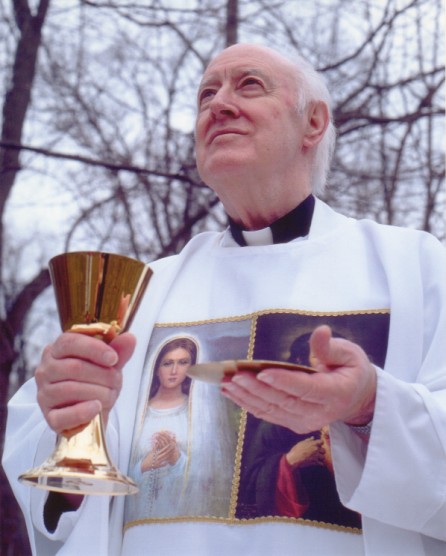
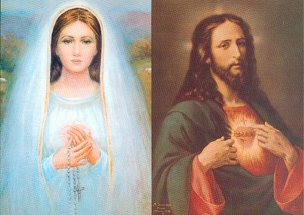
A Prayer before the Holy Sacrifice of the Mass
Let me be a holy sacrifice and unite with God in the sacrament of His greatest love.
I want to be one in Him in this act of love, where He gives Himself to me and I give myself as a sacrifice to Him. Let me be a holy sacrifice as I become one with Him in this my act of greatest love to Him.
Let me unite with Him more, that I may more deeply love Him. May I help make reparation to His adorable Heart and the heart of His Mother, Mary. With greatest love, I offer myself to You and pray that You will accept my sacrifice of greatest love. I give myself to You and unite in Your gift of Yourself to me. Come and possess my soul.
Cleanse me, strengthen me, heal me. Dear Holy Spirit act in the heart of Mary to make me more and more like Jesus.
Father, I offer this my sacrifice, myself united to Jesus in the Holy Spirit to You. Help me to love God more deeply in this act of my greatest love.
Give me the grace to grow in my knowledge, love and service of You and for this to be my greatest participation in the Mass. Give me the greatest graces to love You so deeply in this Mass, You who are so worthy of my love.
-Mass Book, December 27, 1995

L
ET US LOVE THE TWO HEARTS OF JESUS AND MARY
IN THE RECEPTION OF THE HOLY EUCHARIST.HE GAVE HIMSELF TO US ON THE CROSS. HE GIVES HIMSELF TO US IN THE EUCHARIST.
How great was the act of love, God gave to this world, when He gave Himself and died on the cross. He gives Himself to us this day in the Holy Eucharist.
The greatest commandment is that we must love God with our whole heart, our whole soul, and our whole being. This is a commandment. If we are to enter heaven, we must follow the commandments. They are commands given by God for us to follow.
The greatest act we can do on this earth is an act of loving God. The reason for our existence is to love God. In the sacrament of His greatest love, He gives Himself to us. This is an act of love on His part. We are called to respond by giving ourselves in love to Him.
This is the purpose of the Holy Eucharist: to unite in such oneness with our Holy, Loving God. Our all consuming passion should be that of loving God. How many go to the Eucharist with the sole purpose of giving great love to God? He wants us to love Him. He wants souls to tell Him how much they truly love Him. This is the most intimate act of love when Jesus gives Himself-Body, Blood, Soul, and Divinity to man. If it is such an act of love, how are we receiving Him in Communion? We should beg God, in this most intimate union with Him, to help us to love Him with greatest love.
Jesus is a Person. He wants our love. The Holy Spirit wants such intimacy with us. Our Father wants us to love Him. In the Eucharist, we unite with God. In this intimate act of uniting with our beloved God, with Divinity, we must pour out our love to God. We must pour out our heart to the most adorable Heart of Jesus. Jesus is so unjustly treated by many of His beloved souls He loves so much. Let us help make reparation to the Almighty God by loving God with our whole heart, our whole soul, and our whole being in the sacrament of His greatest love. This is the Gift of Himself.
Think of how it is to love someone and give your all for that person, to pour out your heart to him or her and then be treated with coldness and neglect. It hurts our heart so much more when we deeply love someone to be rejected by that person. Jesus loves us with the deepest love. We cannot fully comprehend this love. Let us love Him with the deepest love. Let us love Mary and her Immaculate Heart. Let us love her as the Mother of God. Let us love her as the virgin who bore the Son of God. May we, in the reception of the Eucharist pour out our love to Him, to this adorable Heart. May we pour out our love to His Holy Mother.
Mary said at Fatima that Jesus wants His Heart venerated next to the heart of His Mother. Let us love these two Hearts as we receive the Sacrament of the Eucharist. Then we are so deeply united with God. We see Their two Hearts surrounded with thorns for the injustices against Their Hearts. Let us help make reparation daily as we receive Him in the Eucharist. This is a special time to help make reparation to Their wounded Hearts.
Let us remember how He poured His love out to us on the cross and how He pours out His love to us now when He gives us Himself in the Eucharist, the Eucharist which contains His Heart of burning love. His Heart was pierced with a lance. Her heart was invisibly pierced with a sword. As the wounds in Their Hearts are deep, so too is Their love so deep.
He does not want "surface love". He wants hearts filled with deep burning love.
end of December 27, 1995
Help us get out these books
Betty is a handmaid who has prayed in the
China Church for 11 years. To get from her
house to the church she uses a walker and
must go over a creek and a little bridge.
We wanted a little place she could rest
by the Church. We need about $1,000 to
make this happen. Can you help us?
We are trying to get
Response to God's Love
and the Mass Book out.
Anybody who wants to help us
with a donation to get these 2 books
out in the Priestly/hierarchy mailing —
Please call Kathleen 1-888-211-3041
July 31, 1994
Words of Jesus to Members of
Shepherds of Christ Associates:"My beloved priest-companion, I intend to use the priestly newsletter, Shepherds of Christ, and the movement, Shepherds of Christ Associates, in a powerful way for the renewal of My Church and the world.
"I will use the newsletter and the chapters of Shepherds of Christ Associates as a powerful instrument for spreading devotion to My Heart and My Mother's Heart.
"I am calling many to become members of Shepherds of Christ Associates. To all of them I will give great blessings. I will use them as instruments to help bring about the triumph of the Immaculate Heart and the reign of My Sacred Heart. I will give great graces to the members of Shepherds of Christ Associates. I will call them to be deeply united to My Heart and to Mary's Heart as I lead them ever closer to My Father in the Holy Spirit."
- Message from Jesus to Father Edward J. Carter, S.J., Founder, as given on July 31, 1994,
feast of Saint Ignatius Loyola, Founder of the Society of Jesus (The Jesuits)
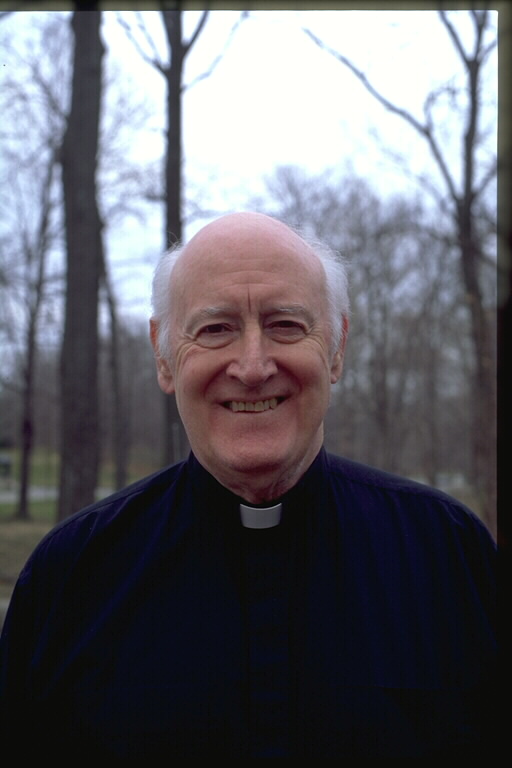
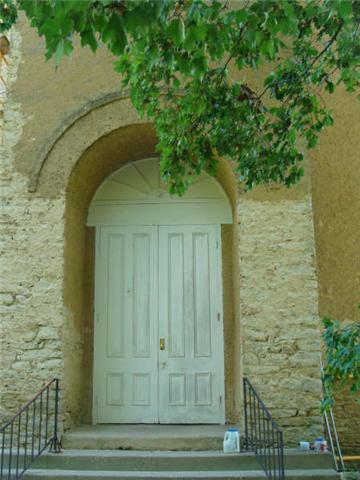
The China Church is over 140 years old
and we pray in there 24 hours a day.
It needs stucco and so does
the community building.
Can you please help us?
Call Kathleen 1-888-211-3041
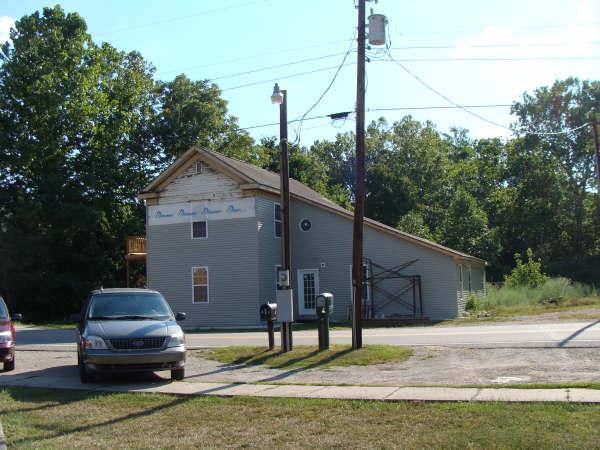
Likewise the priest house
is 150 years old.
Jesus told us to repair it
which we have been doing.
We need $13,000.00 for this work.
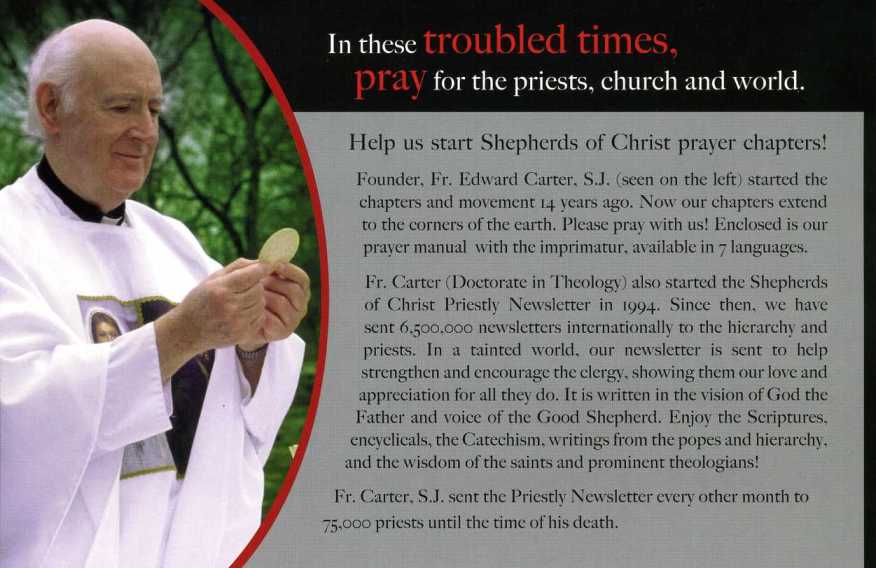
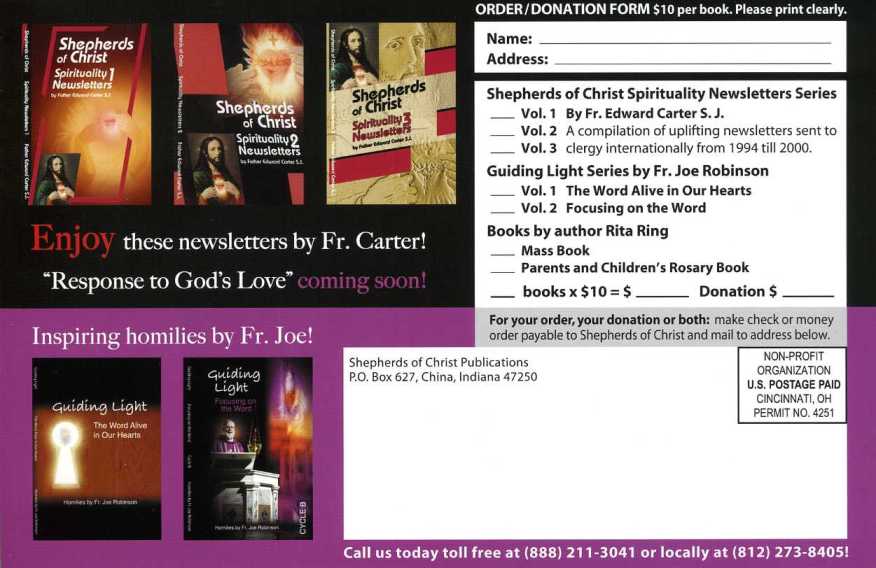
You can help put the Blue Book V
in the hands of 1,000 people
we need $1,200 postage for this
It is ready to go
Call Kathleen
1-888-211-3041
You can help put Fr. Joe's homily
book in the hands of
1,000 priests — it costs $1,100
This can help 1,000 parish priests
talk about Covenant for Lent
Please help us
It is ready to go
Call Kathleen 1-888-211-3041
Call Kathleen to Order any of the items below
1-888-211-3041